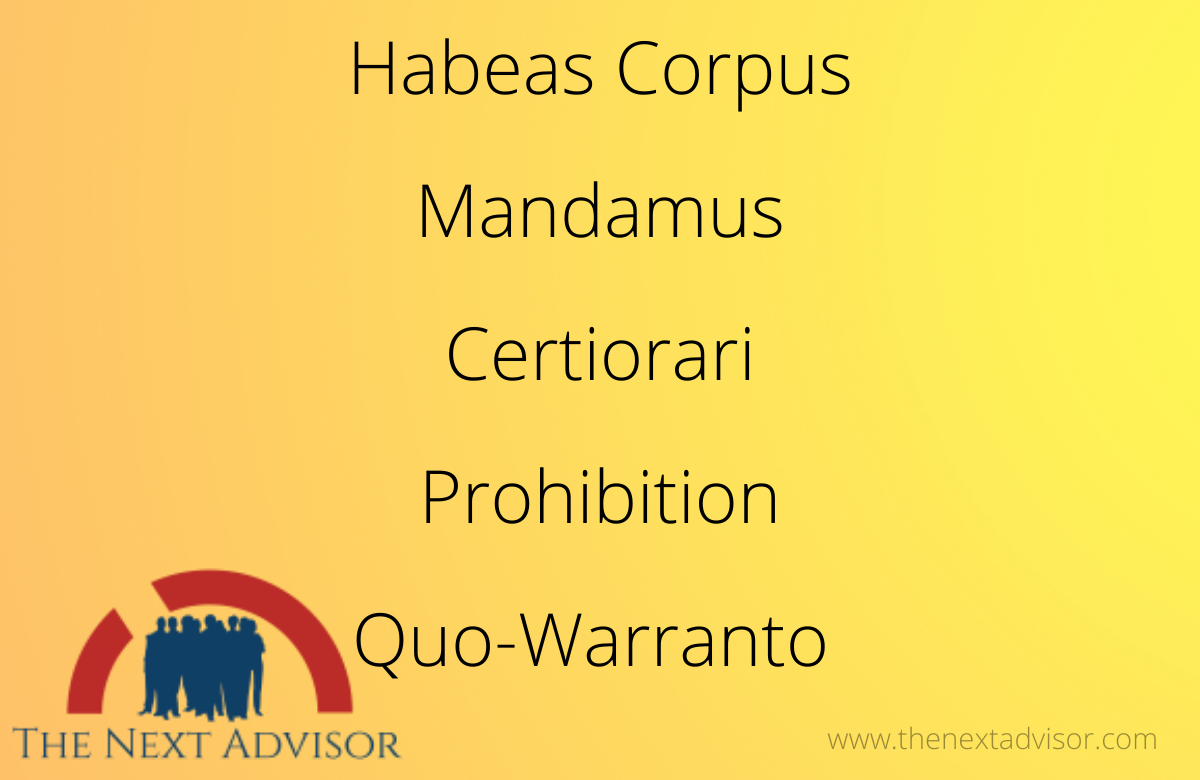Hey, first let me intro you to the topic and the topic is Articles 32 and 226 of the Indian Constitution and Writs in detail. Suppose this is your private property. But – To protect that property you are not allowed to build a fence around your property, You are not allowed to do any construction around it. Nor are you allowed to evict a trespasser. In these circumstances can you properly enjoy your Property?
Hey, everybody, today I brought a perfect topic for you i.e. Five kinds of writs, about the protection of FRs, mainly about Article 32 and Article 226, with Important case laws.
Let’s start with first understanding the meaning of writs. So, we have been provided with different rights like the right to education, rights to dignity, right to life. But just like the Example, there is no meaning of Rights until they are properly protected. To put it simply whenever we buy any Jewellery, the first thing we think about it is its safekeeping. Just like that, for the protection of our fundamental rights and their safeguards, we have some constitutional Remedies. Protection of FRs has been discussed mainly in these Four Articles.
First Article 13- Which talks about judicial Review. Next is Article 359- Which says that FRs cannot be curtailed; except during emergencies. And then we have Article 32 and Article 226, which I am going to explain to you. Part III of the constitution talks about FRs- It extends from Article 12 to Article 35. This means that Article 32 which is my topic, is in itself an FR.
Now, Article 32 mainly talks about two types of Rights and Powers. D.R. B.R.Ambedkar has called this Article the “Heart and Soul of the Constitution”. The powers which are vested under Article 32, the same powers are also given under Article 226. By using Article 226- You can approach a High Court. Thus, these two Articles give you the power to approach the Highest Court of the Country, in case your Fundamental Rights are violated. Also, to protect your rights.
It is not a rule that you first approach the High Court and then only approach the Supreme Court. Although. When you directly approach Supreme Court, you will have to explain, why you did not first approach the High Court. Article 32 and 226 both provide for the issuance of writs. But there are 2 major differences between these Articles.
The writ issuing power laid down under
- Article 32 is only limited to the protection of FRs. Whereas under Article 226 writ could be issued for any other purpose in addition to FRs. For Example:- A writ against the decision of an administrative tribunal.
- The second difference- As Article 32 falls under part III of the Constitution, the Constitutional remedy under it is an FRS. Whereas the remedy under Article 226 is not an FR.
Now, Let’s start with our main topic. But let me explain a fact first.

Five Writs
There are 5 types of the writ.
- Habeas Corpus.
- Mandamus
- Certiorari
- Prohibition
- Quo-Warranto
All 5 of them are Latin terms. Till now we have understood that ‘writ’ means a kind of a remedy. So, the writ has been classified into 5 heads.
1. Writ of Habeas Corpus:- it means to have a body. To produce a body. This is the most powerful and most used writ. See, if the state illegally detains a person then such an individual by himself or through his relative or friends can use the writ of Habeas Corpus, for the release of that person. So, whenever you use this writ Supreme Court or the High court asks the detaining authority on what basis the person was detained. If the basis is found to be unreasonable, then the detention ends and he is to be released with immediate effect.
You can not use the writ of Habeas Corpus in the following conditions.
- Detention is Lawful.
- Contempt of Court.
- Detention is Outside the Jurisdiction of The Court.
- Detention is by A Competent Court
In this case, a person who had already completed his period of detention was still kept in prison for EXTRA 14 YRS. In this case, the writ of Habeas Corpus was used which led to his immediate release. Additionally, he was given Exemplary Damages.
So, writ of Habeas Corpus is used to demand the production or release of a person who is illegally detained.
2. Writ of Mandamus:- which means ‘We Command’. You can use this website on any statutory, Non-statutory, University, Tribunal, etc.. and command them to perform their public duty. i.e, Through this writ, you can command a public official to perform his public duty.
Let me explain to you the case law to understand this writ.
Gujarat State Financial Corporation V. Lotus Hotels.
In this case, the financial Co-op had an agreement with the lotus Hotels. That we will release the funds. So that you can complete your construction work. Later, they refuse to release the funds. So, Lotus Hotels approach the Gujrat High Court by using the writ of Mandamus. Directs the authority to perform the public duty which it promised to perform. There is 1 condition pre-requisite for the application of writ of Mandamus is there should be a public duty.
3. Writ of Certiorari:- which means ‘to be certified’. Through this writ, Supreme Court and High Court can command the Lower Court to submit its records for their review. In the review, it is checked that whether the Lower Court Judgements are illegal or not.
Now when can Lower Courts judgments be illegal?
A) Excess of Jurisdiction
B) Lack of Jurisdiction
C) Jurisdiction is Unconstitutional
D) Violation of principles of natural justice.
If the Lower Courts judgments are to be illegal then they are quashed. This means that their judgment has no value now and is not to be followed.
Now Look at these two cases:-
Gullapalli Nageswara Raw VS. APSRTC
And
A.K.Kralpak VS. Union of India
Both these cases are important for competitive exams and both these cases are related to the writ of certiorari. In, both cases their Lower Courts judgment was held to be illegal and therefore quashed.
4. Writ of Prohibition:- Prohibition and Certiorari have a few differences. You must have heard of this statement, “prevention is better than cure”. The difference between prevention and cure is the same difference that exists between prohibition and certiorari.
Remember it this way P = Prevention = Prohibition. C = Cure = Certiorary.
As we have learned that if an illegal judgment is announced then to quashed. It is to cure the mistake. You have to use Certiorari. But, if before the judgment is announced, if before the judgment is announced, if you want to prevent the mistake, then you use the Writ of Prohibition.
Prohibition =”To Forbid”
So Prohibition is used until the Lower Court has pronounced an illegal Judgment, then you use Certiorari.
5. Writ of ‘Quo Warranto:- Let’s understand the 5th writ with the help of a simple example. Suppose that you are a College student, therefore I am safely assuming that you must have cleared college Entrance Eligibility. Whether it is cleaning the 12th board or getting minimum marks required or qualifying Entrance Exam. You must have qualified in College’s Entrance Eligibility.
If it is found out that you have not cleared the entrance eligibility then you can be removed from the College. Exactly this principle is followed in the writ of Quo Warranto, which means, ‘By What Authority.
By using this writ court can question any public officer that by what authority have you assumed this Public Office?
This is all about Article 32 and Article 226 of the Indian Constitution and the explanation of Five Writs in very simple language. To understand it more deeply please refer –https://www.thenextadvisor.com/all-about-public-interest-litigation/

























